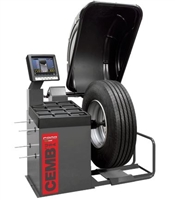Wheel Balancer Buying Guide
Wheel balancing is an important part of vehicle maintenance and is something that most shops will be asked for regularly. This process ensures the performance of a vehicle, especially at high speed, by ensuring it handles smoothly and consistently. If you're a reputable technician and have an auto repair business, it's important to find the best equipment to ensure you perform high-quality work and deliver top performance for the vehicle you're attending to. If you are not sure how to find the right equipment for your shop, learn more about narrowing down your selection with this wheel balancer buying guide.

The two main types of wheel balancers available on the market are static and dynamic. Many modern machines come with options for both, but not all, and it is important to know the difference when shopping for the right model for your shop.
Static wheel balances operate without moving the wheel. They use weight in only one spot on the inside of the wheel to measure the imbalance. Once the tire is placed on its vertical axis and secure, it can be checked with sensors or an oil-filled glass sighting gauge, showing the imbalance of the wheel in seconds. This is primarily reserved for wheels that cannot take weight on the exterior and is mostly used for heavy duty tires such as those for large trucks and other commercial or industrial vehicles.
Recent technological improvements have enabled dynamic balancers to outperform static balancers for small vehicles that are more sensitive to minor variations. Dynamic wheel balancers operate by using weights on the inside and outside of the wheel. By using a spin balancer, they can check the imbalance of the wheel while it is in motion, mimicking the actual performance it would have on the road. Computers can then give a very accurate and precise reading for the wheel, and many machines are capable of handling this task in just a few minutes.
While dynamic wheel balancers offer an improved level of precision, skilled technicians can perform a fantastic balancing job with a static machine. However, some customers might insist on the use of a dynamic balancer. There are several factors to consider when choosing the right model for your shop. Here are some quick tips to remember during your search:
When it comes to price, basic dynamic wheel balancers can range from $1,000 to $4,000 or more, with diagnostic and premium balancers going up to $15,000. For those on a tight budget, static balancers can be as little as a few hundred dollars, with most models coming in at under $1,000. Smaller family shops that are on a budget might not have the budget for an expensive, state of the art diagnostic balancer, but there are still very affordable dynamic balancers to choose from if you are looking for increased capabilities.
The volume and variability of your work is important as well. Static balancers are often simpler machines, and while they can allow for a large degree of variation, dynamic balancers are often capable of handling a larger range of vehicles through the use of various attachments. If you own a busy shop that gets a lot of traffic from a large range of customers, consider investing in a dynamic balancer for improved performance and an easier time handling many different wheels every day.
The experience level of your mechanics can also make your choice simple. Many veteran technicians can achieve a great level of performance from static balancing. However, the more modern technology and computer-assisted precision of dynamic balancers will ensure newer and less experienced operators are able to do a great job. If you are trusting this job to newer mechanics, ensuring they have access to a dynamic balancer will help guarantee they do a fantastic job every time.
|
Homepage


Installation & Delivery, Service, Parts, Will Call
Locations Across The Nation
TO SERVE
THE ENTIRE
COUNTRY








 Owned & Operated in the U.S. since 1987
Owned & Operated in the U.S. since 1987




